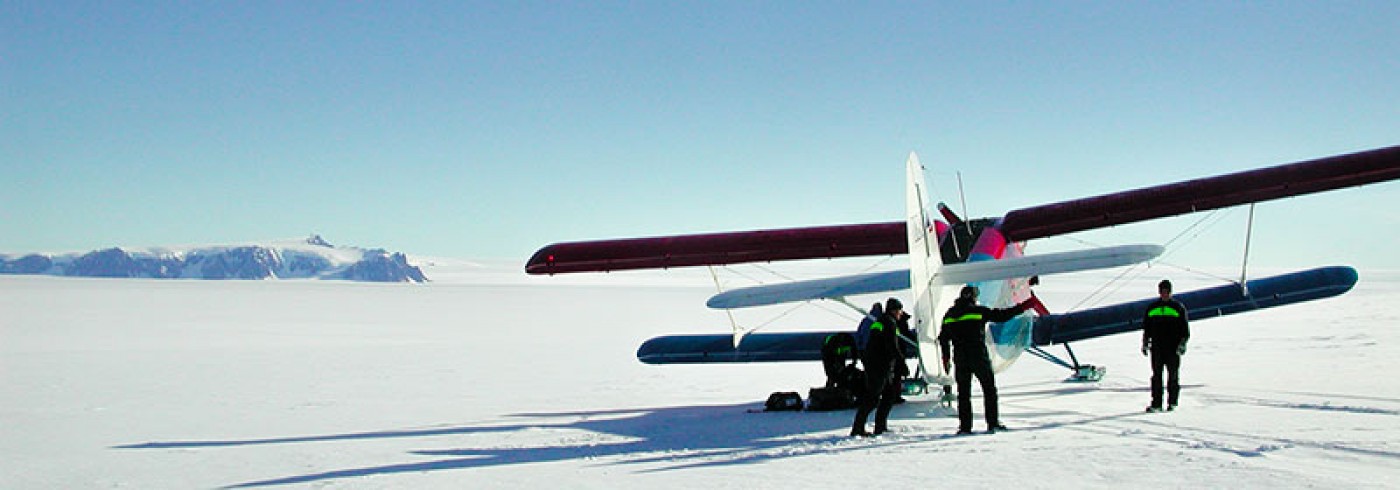Evaluation of air transportation between South Africa and Antarctica
Since the 1980’s, flights to Dronning Maud Land in East Antarctica have been carried out within the Russian Antarctic programme. However, it was not until the Antarctic summer season 1997/98 that air transportation to Dronning Maud Land became available to other national operators. In that season, the commercial company Polar Logistics transported scientific personnel from Cape Town, via the blue ice field runway Blue One, to the South African station SANAE IV. This showed the nations operating in Dronning Maud Land that there really was an alternative to long ship journeys. In 1998, the Finnish, Norwegian, and Swedish Antarctic programmes decided that any flight operation between Cape Town and Dronning Maud Land should be preceded by an evaluation. As national agencies, the Nordic Antarctic programmes wanted to make sure that such flight operations met high standards, e.g. with regards to safety. Through Jan-Erling Haugland the Norwegian Polar Institute undertook to organise an evaluation flight between Cape Town and Dronning Maud Land in the Antarctic summer of 1999/2000. However, due to the limited number of companies willing and able to perform such flights, it was not possible to do it that season, and the evaluation was postponed one year.
In the season 2000/01, Australia, Finland, Germany, Japan, the Netherlands, Norway, South Africa and Sweden, co-ordinated by Jan-Erling Haugland, made an evaluation of flights between Cape Town and Dronning Maud Land and flights within Dronning Maud Land. Through Polar Logistics an Ilyushin-76 MD (IL-76) was chartered for the trans-oceanic flights. The flights within Dronning Maud Land were done with Polar Logistics’ own Basler Turbo-67 (BT-67) and a chartered DeHavilland Twin Otter. The IL-76 is a four-engined, Russian-built jet, very suitable for unconventional landing areas, and which has a very high cargo capacity. The BT-67 is a thoroughly renovated Douglas DC-3, refitted with turboprop engines. The Twin Otter is one of the world’s most used small ”bush planes”, and the type is extensively used in Antarctica. Both the BT-67 and the Twin Otter were ski-equipped. The evaluation team members represented national Antarctic programmes, being mainly logistics and operations officers, as well as representatives of civil aviation authorities and military air forces. Thus the participants together had a vast experience of Antarctic operations and flight operations. The landing area in Dronning Maud Land was the blue ice field Henriksenskjera, with a runway and camp named Blue One by Polar Logistics, which functioned as a flight hub. The camp is a temporary tented camp, staffed by Polar Logistics, with basic amenities and safety arrangements. From Blue One, the Swedish participants visited some of the stations in Dronning Maud Land, Troll (Norway), Aboa (Finland), Wasa (Sweden), Georg von Neumayer (Germany), and SANAE IV (South Africa), and also the EPICA project drilling site Kohnen Base. Other evaluation team participants also visited Novolazarevskaya (Russia), Maitri (India), and Tor (Norway) stations. The time on the ice for the evaluation team was approximately 48 hours, and the transoceanic flights took some 5.5 hours one way. On the transoceanic flight from Cape Town to Dronning Maud Land, with an IL-76 the ”point of safe return” lies a mere 30 minutes from landing.
The evaluation group concluded that flights into Dronning Maud Land from Cape Town are quite feasible and can be done within acceptable standards of safety, and that Cape Town is a suitable ”gateway” for flights to Dronning Maud Land. The types of aeroplane used during the evaluation are also suitable for their respective tasks. However, Blue One is not an optimal flight hub. For instance, weather can cause week-long delays, and a more fully built-up station could provide greater comforts for aircraft crews. The air operations should rather be focussed around a permanent, year-round station which can provide a better infrastructure, runway maintenance and service, e.g. meteorological, than a temporary camp can. To further develop the concept, a working group was formed by the interested parties at the COMNAP meeting in Amsterdam, 2001. The DROMLAN (Dronning Maud Land Air Network) working group consists of representatives from Australia, Finland, Germany, Japan, Norway, Russia, South Africa and Sweden, under the chairmanship of Jan-Erling Haugland. Their first task is to look into alternative solutions for the season 2002/03. From the Swedish side, as there will be a different commercial operator, INTAARI, in the season 2001/02 than the one used during the evaluation, the Swedish Polar Research Secretariat will have Captain Göran Wästhed, who was a member of the Swedish evaluation team, accompanying one of the flights to Dronning Maud Land. The landing site used in 2001/02 will be at the Russian Novolazarevskaya station. The Secretariat has worked with INTAARI on several occasions, both in the Russian Arctic and in the Antarctic.
Dates
1–7 January 2001
Participants
Project leader
Magnus Augner
Swedish Polar Research Secretariat
Stockholm, Sweden
Dick Hedberg
Polar Research Committee, Royal Academy of Sciences
Stockholm, Sweden
Ulf Hedman
Swedish Polar Research Secretariat
Stockholm, Sweden
Tomas Karlberg
Swedish Polar Research Secretariat
Stockholm, Sweden
Göran Wästhed
Air Transport School, The Skaraborgs Air Force Base F7
Såtenäs, Sweden
*Not participating in the expedition

